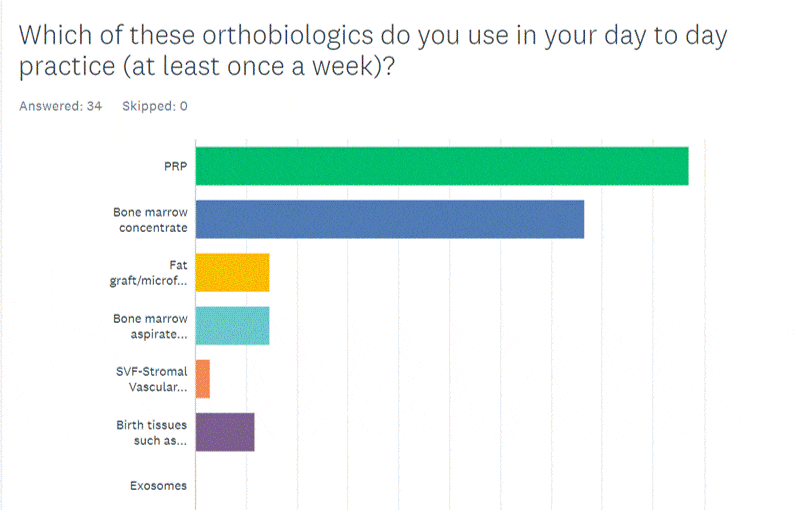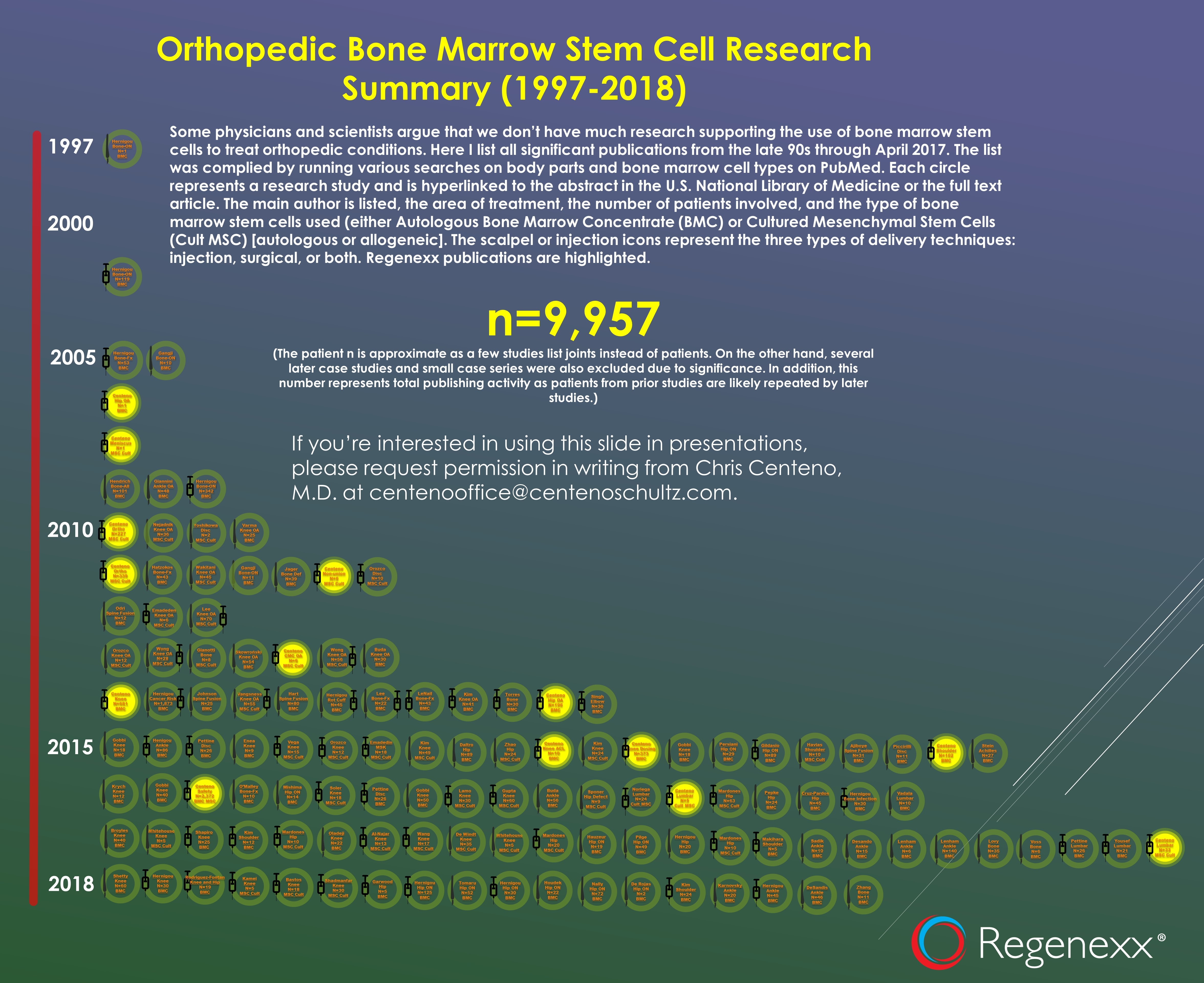There Are Two Worlds of Regen Med, Please Don’t Confuse Them…
This Friday I lectured at the TOBI conference in Chicago. This is a great annual event that brings together many high-level researchers and clinicians involved in orthobiologics research. It was almost surreal lecturing at and attending this conference, listening to countless academic physicians who are using orthobiologics, and at the same time realizing that the media continues to confuse what they’re talking about with miracle cures hawked at a growing number of clinics around the country. Let me explain.
What are Orthobiologics?
Orthobiologics are substances that can enhance orthopedic healing. The two most common in use today are by far platelet-rich plasma and bone marrow concentrate. In fact, that’s born out by a quick poll I ran on a Linkedin group where more than 7,200 physicians, academics, and industry representatives exchange ideas (Biologic Orthopedics Society):

The Miracle Cure Clinics
This has been a hectic week for media coverage on miracle cure clinics. In fact, this past week the FDA won a major court victory over US Stem Cell, a clinic using illegally enzyme digested fat to treat a host of diseases from impotence, to ALS, macular degeneration, and diabetes. However, US Stem Cell is just the tip of the miracle cure iceberg. So let’s classify these clinics into two main types:
- Fat Stem Cell IV Clinic: This is the US Stem Cell type. They treat a variety of incurable diseases, usually through IV injection of the patient’s liposuction harvested, enzyme-digested fat. Another such clinic chain is Cell Surgical Network, which has a pending court case with FDA.
- The Magic Birth Tissues Clinic: These clinics purchase birth tissues like amniotic fluid, umbilical cord blood, or Wharton’s Jelly and are usually alternative medicine based. The birth tissues being injected are dead but are advertised as having millions of live stem cells. The most common set up is that a chiropractor owns the clinic and hires a mid-level provider like a nurse or a physician’s assistant to inject patients. Sometimes a physician is contracted to come in and perform procedures. The clinics run very aggressive marketing campaigns and tend to focus on the elderly. Many treat arthritis by showing fraudulent before and after x-ray results that purport to demonstrate that new cartilage was grown in a severely arthritic knee. However, many also treat incurable diseases just like the Fat IV stem cell clinics.
None of these clinics have significant published evidence to support that these tissues are effective for all of these diseases. Also, a new “disease” now being treated is in fact “aging”. Meaning that we’re now seeing clinics pop up that proport to stop or alter the aging process through these therapies.
Orthobiologics Use
I got asked this weekend where bone marrow concentrate began (BMC). First, bone marrow concentrate is an autologous orthobiologic obtained from centrifuged bone marrow aspirate. It definitely contains mesenchymal and other types of cells and so far, the early data suggests that its success or failure depends on its mesenchymal stem cell content.
You might think that using BMC is new. Nope, in fact, it’s an old therapy that was first used in common orthopedic bone healing applications in the late 80s with publications by Herigou and others in Europe. The first significant case series for using BMC to heal non-union fractures was published in 1997, some 22 years ago. We began using it in 2005 and were the first to apply it using image-guided injection techniques to treat many orthopedic problems like arthritis and tendon tears.
The clinics that use orthobiologics are very different than the miracle cure clinics described above. They tend to be only focused on orthopedic care and also tend to use the existing published research as evidence to support use. In fact, as of last year, here was all of the published research in bone marrow stem cells for orthopedic applications (click to see PDF):
The TOBI Conference
While lecturing at TOBI, I noted that we had academic physicians from the following universities and organizations using orthobiologics and either presenting or being represented:
- Stanford
- Mayo Clinic
- Harvard
- Clevland Clinic
- Baylor College of Medicine
- Rush University
- UPMC
- HSS
- Univ. of Western Australia
- Emory
- USC
- US Army
- Cedars-Sinai Kerlan-Jobe Institute
- University of Colorado School of Medicine
- Instituto Cugat, Barcelona, Spain
Why are all of these academic physicians using PRP and BMC? There’s enough evidence to support use in patients for whom either no good option exists, or the option is far more invasive than the planned therapy. Meaning, while these are physician-scientists, they’re also doctors who practice in the real world where large randomized controlled trials are often not available to guide patient care in most clinical indications. Hence, they are not hawkers of miracle cures, but scientists using the best available evidence to guide their clinical decisions.
The Bench Scientist Point of View
Bench scientists who perform stem cell research and some physicians who are heavily involved in the commercialization of university-based stem cell therapies have long wanted all cellular therapies to be classified as prescription drugs. Why? On the one hand, this position maximizes the number of federal grants and university funded commercial ventures. Meaning, it maximizes the cash in university coffers. On the other hand, given the out of control explosion of irresponsible stem cell use, this point of view may have also been a bit prophetic and certainly has some merit. However, the same university professors on this side of the argument also lump orthobiologics into the same basket as miracle cures. This is despite a growing army of physician academics (i.e. like the ones lecturing at TOBI) from the medical school side of campus who clearly disagree with that position.
The One-Sided Stem Cell News Story
As I was sitting there watching many university-based physician-scientists give lectures about their orthobiologics use and research, I was having an email exchange with an oft-quoted bench scientist who was clearly trying to throw orthobiologics into the same category as the crazy stuff out there. I was also reading new stories on my laptop where other university talking heads were doing the same. How could this disconnect happen between the two sides of campus?
Basically, the media isn’t educated on this topic and they’re only listening to talking heads on one side of campus while ignoring actual practicing physician-scientists on the other side of campus. The university scientists that oppose stem cell use are basically the only ones sought for a quote. Hence, the stories all have a very slanted point of view that ignores the position of other academics who would disagree.
I really wanted to blink a few science reporters to this conference. Just so that they could see that they can’t write a balanced story without also quoting some of the academics that were lecturing. What does the Pew Reseach Center say about not getting both points of view?
The Pew Research Center: Core Principles of Journalism
The Pew Research Center defines the standards for journalism. In a recent poll of widely held values, 98% of Journalists and News Executives said that getting both sides of story was critical. If that’s the case, why do we see so many one-sided stories in this space? Meaning, journalists have an ethical obligation to let the public know that the opinion of a university bench scientist or bioethicist at one institution may be opposed by a university physician at the same or another institution. That’s not happening right now on the topic of orthobiologics.
The upshot? Orthobiologics are VERY different than the stem cell wild west. Conferences like TOBI and IOF where university professors discuss the best ways to use these therapies are key drivers of responsible use. Now we just need to educate the media that both sides of campus need to get their points of view quoted.

If you have questions or comments about this blog post, please email us at [email protected]
NOTE: This blog post provides general information to help the reader better understand regenerative medicine, musculoskeletal health, and related subjects. All content provided in this blog, website, or any linked materials, including text, graphics, images, patient profiles, outcomes, and information, are not intended and should not be considered or used as a substitute for medical advice, diagnosis, or treatment. Please always consult with a professional and certified healthcare provider to discuss if a treatment is right for you.
